Metaphysics & Spirituality — Issue 3, 2016
A Caravan on a Spiritual Silk Road
Warren Kenton talks about the ancient Jewish tradition of Kabbalah and what it can teach us in the present day
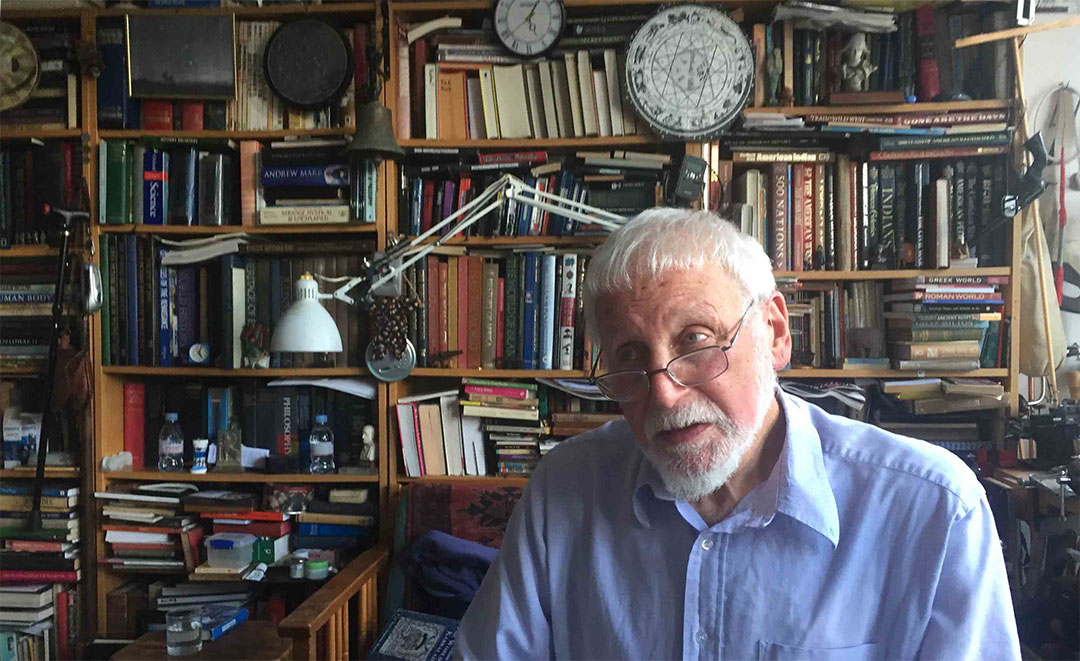

A Caravan on a Spiritual Silk Road
Warren Kenton talks about the ancient Jewish tradition of Kabbalah and what it can teach us in the present day
Warren Kenton has been studying Kabbalah, the mystical tradition of Judaism, for more than 60 years. Specialising in the Toledano tradition which developed in medieval Spain, he has taught all over the world, and is the founder of the Kabbalah Society. He is also a prolific author, producing, under his family name Z’ev Shimon Halevi, more than 17 books, including ‘Kabbalah: Tradition of Hidden Knowledge’ (1989); ‘The School of the Soul’ (1985) and ‘Kabbalah: The Divine Plan’ (2013). Now in his 80s, he continues work and oversee the instruction of his many students. Jane Clark and David Hornsby talked to him at his home in London.
 David: What is Kabbalah?
David: What is Kabbalah?
Warren: The Kabbalah is the esoteric tradition of Judaism. It has its roots in the religion and is based on the Bible and the Torah, but in every age it has been cast in a form of expression suitable to that particular time. In the classical period – roughly the eleventh to thirteenth centuries – the Jews came across neo-Platonism. There was an encounter between Hellenic thought and the Judaic mystical tradition, and various people in places such as Gerona, Toledo and Léon in Spain put the two systems together. That is where you get the birth of Kabbalah.
Similar things were going on at about that time within the Sufi tradition, and also within Christendom with the emergence of scholastic theology and such like. There was quite a lot of interaction between Christian, Jewish and Arab scholars in places such as Chartres and the royal courts of the Mediterranean region. Members of the three religions had an ‘official’ position concerning their attitudes towards one another, but there was also what one might call an ‘unofficial intelligentsia’ who would meet discreetly and exchange ideas. Many Jews who could speak Arabic acted as intermediaries, allowing the Christians and the Muslims to communicate with each other.
David: We gather that it was at this time that the Tree of Life diagram, which everyone has come to associate with Kabbalah, came into being.
Warren: It is likely that it had existed before, discreetly, but this was the time to bring it into the open. The Menorah, the seven-branched symbol of the candlestick, is essentially the same as the Tree of Life, but it was redesigned in this medieval period into a more metaphysical form. Various versions of the Tree were generated, and the classical one which we now use turned out to be the one that worked best.
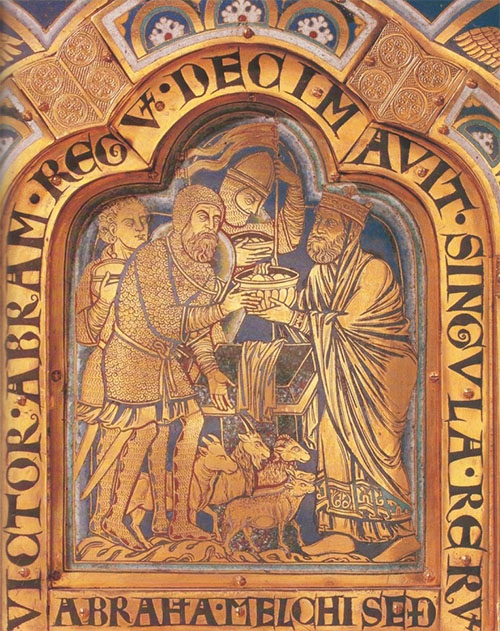
Melchizedek initiating Abraham. Gold and enamel altar plaque by Nichola de Verdun at Klosterneuberg, Austria, 12th century. © Erich Lessing / lessingimages.com
David: In one of your books you describe Kabbalah as having Abrahamic roots?
Warren: According to tradition, this dates back to Abraham’s initiation by Melchizedek at the site of the future Jerusalem. Melchizedek is the first fully realised individual. In the Old Testament he is known as Enoch, and in Islam as Idris; he is a manifestation of al-Khidr. So, Kabbalah is essentially the Jewish version of the eternal teaching that you find in all the spiritual traditions. The Tree of Life is a universal archetype, but it is represented in different ways in different cultures. You can see the same idea in the depiction of the chakras in Hinduism, in Tibetan Buddhism and in the Taoist understanding of the I Ching. And the essential message of Kabbalah is the same as in all other traditions; it is to remember where you came from, why you are here, and what you are meant to do – which is that you are here to serve.
David: Is Kabbalah only for Jews?
Warren: No, of course not. Remember what it says in the Bible: that Abraham would be the father of many peoples. This does not mean tribalism; what it means is that he was the father of many schools of the soul. The three main lines of the Semitic religions – Judaism, Christianity and Islam – originate from Abraham, and within them there are many sub-lines, because there are Jews who disagree with each other just as much as they disagree with people from other faiths.
Jane: How did you yourself encounter Kabbalah?
Warren: I come from a rabbinical family. We are Levites, who were the priests and teachers in ancient Israel, and so it was natural that I should be attracted to the esoteric tradition of my ancestors. I always write under my Hebrew family name, which is Z’ev ben Shimon Halevi: Wolf, the son of Simon the Levite. While ‘the tradition’ as such was never talked about at home, there was always something present behind the outer form of the religion, but it was too deep to be discussed in a domestic context.
My first intimations came when, as a student, I hitch-hiked to Toledo in Spain. As I walked the old streets I thought to myself, I know this place: I had very strong memories of the city in the Middle Ages. And it was the same for Malaga and Gerona. So, in the beginning, my relationship with the tradition was to do with memories and reconnection. After this I was a student for about twelve years at the Study Society in London founded by Ouspensky – a remarkable seeker of truth who had studied under Gurdjieff. He used the most recent formulations of the teaching in relatively modern terms and without a religious context, which meant that we could sit and talk about cosmology without mentioning the word ‘God’. This gave me a good, solid psychological and esoteric training, so that when I came across the Kabbalah, I felt that I recognised what was being said. The Ouspensky training gave me the metaphysical key to Kabbalah, and made me think that I could make it intelligible to the modern mind. So I married this contemporary view of science and psychology with the ancient and medieval Jewish tradition.
Jane: How old were you then?
Warren: In my thirties. I realised then that this was to be my work, and I began an investigation of the classic works of the Kabbalistic tradition such as The Zohar and the Sefer Yezira (Book of Formation). At about this time, I also came into contact with a non-sectarian Kabbalistic group which opened up another dimension – of inner experience as well as theory. This enabled me to separate out the essence of Kabbalah from what had become a rigid orthodox belief system. For instance, I remember as a child sitting with my grandfather at Passover, surrounded by the whole Sephardi family, and thinking: what’s this ceremony really all about? The answer I got was that it’s about the exodus from the slavery in Egypt, and crossing the desert of development into the Holy Land of the higher worlds. The memory of this journey was buried in my unconscious: I knew what it was, but I couldn’t articulate it until I had a language and a system.
So in my thirties I began to understand the Book of Exodus as an analogue of an individual’s psychological and spiritual development. The Israelite slaves in Egypt represent our social conditioning, while the forty years in the wilderness is a symbol for purification and dissolving of the mindset of those born in Egypt, which is the mundane world. The turning point comes at Mount Sinai when the Torah, or Teaching, is given: from here on the older ‘slave-minded’ people begin to die off and a new generation, open to development, is tested and tried in order to become a unified nation – meaning an integrated psyche. Then they are ready to enter the Holy Land, which is the world of the spirit.
This kind of Kabbalistic interpretation of traditional texts transforms history into a metaphor of human evolution. When I was asked what I wanted to be as a boy, I said that I wanted to be an archaeologist. It was only much later that I came to recognise the significance of my great love of history: that for me, it would be a matter of exploring the history and symbolism of the tradition – what one might call ‘an archaeology of the soul’.
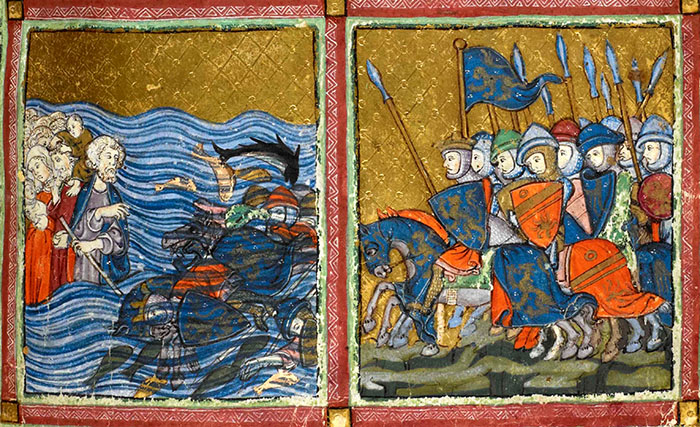
The Israelites escape over the Red Sea, while Pharaoh and his army drown. From The Golden Haggadah, created in Spain during the 1300s. A haggadah, which literally means ‘telling’, is a prayer book that is used during the Jewish festival of Passover. Copyright: The British Library Board, Add.27210, f.14v
David: You are perhaps best known as a writer on Kabbalah, and you currently have some seventeen books in print. When did you start your writing career?
Warren: It was also in my thirties that I set out to be a writer. To begin with all my novels were rejected because publishers said that they were “too spiritual”. Then one day I realised that my métier was non-fiction. From then on my books were published. These became a series on Kabbalah, but they were not written in a scholarly mode as they were aimed at seekers of the path rather than academics. This annoyed some scholars and rabbis who were critical of the lack of learned references in my works. Despite this, many of the books have been translated into foreign languages, including Hebrew, Japanese and Russian.
FOLLOW AND LIKE US
——————————————
——————————————
——————————————
David: Is what you teach and set out in your books a system and a way?
Warren: Yes, there are basically three approaches in Kabbalah: the way of action, the way of devotion and the way of contemplation. An example of action is being alert in the midst of everyday life; the way of devotion is seen in a prayer of the heart, while the way of contemplation is an intellectual overview of universal principles. All three of these approaches can give rise to a shift in consciousness.
The key to the tradition on the contemplative side is presented in the Tree of Life diagram, which explains the basic structure of the whole of existence. It gives a representation of four worlds: the physical world, the world of the soul, the world of the spirit and the divine world – all of which are held together by the will of God. And it also defines the dynamics – the active, passive and equilibrium principles – that govern these worlds. For instance, the aspects of divine mercy and divine justice are seen as the right and left pillars of the Tree, whilst the central, vertical axis represents various degrees of consciousness, which is what is referred to in the Bible as Jacob’s Ladder.
That is the cosmological picture. There is also a version of the Tree which lays out the structure of the human being: and in this case, the four levels are defined as the physical, the psychological, the spiritual and the Divine. When the mind is seen in terms of the Kabbalistic Tree, then much more can be understood. For example, the self – or tiferet on the cosmological diagram – is right in the centre, halfway between the top and bottom, and the left and right of the psyche’s anatomy. This means that we as human beings have access to the three lower worlds, and this gives us a gateway into the eternal world. So, as we progress in realisation, we become increasingly aware of the divine presence at every level. Then the idea that “Lift up the stone, and you will find Me there” becomes obvious. (Gospel of Thomas, 77b) Understanding the Tree also helps us recognise our own current state of mind and stage of development. Some kind of a map is vital on the spiritual path; without one, most people just sleepwalk through life.
Jane: Can you say a little more about how Kabbalah sees the role of humanity in the world?
Warren: Humanity is symbolised in Kabbalah by Adam Kadmon, who is the divine human being before the fall, containing both male and female aspects. The Holy One wants to manifest, to behold Itself, so It makes a space in which existence can come into being. Into that space are projected the divine principles, which when completed take on the form of the divine human being, which contains everything that was, is and shall be. The physical appearance of the human being on earth is subsequent to this, as we see in Genesis when Adam appears quite late in the day. So Adam Kadmon is the primordial image of the divine in pre-time; what is described in Genesis is the beginning of time.
The whole purpose of existence is to come to the realisation of “I AM that I AM”. In the medieval classical book of The Zohar it states that “Face did not gaze upon Face”, which means that “I AM that I AM” was not yet fully realised. Therefore existence is the mirror by which “God can behold God” through our experience. The Kabbalah sees creation as a process which starts at the beginning of time and terminates at the end of time, at what we call the resurrection in Biblical terms. This is a primary concept. It tells us that we are the organs of perception for the Holy One, who is looking through our eyes and hearing through our ears.
David: What is the practical aspect of the path?
Warren: As an artist I like to use visuals that people can relate to. For instance, when we are working in a group, we can use the Tree of Life to contemplate the different levels of existence, such as the seven days of creation emerging out of the divine world. Or, at a more psychological level, we can take an image of a ship, and ask ourselves: what is my kind of ship? Because what we see is how it is for us today. For some people it is a battleship and for others it may be an Arab dhow. We enter the ship; we go inside; we meet the crew and the captain, who are our sub-personalities; we taste the food, and so on. We use images like these as exercises for contemplation. However, the point is not just to contemplate these things intellectually: we need to discover them as symbols of our souls. The contemplation just prepares us for the ascent, which is a moment of meditation when we suddenly realise the depth of the matter and say: “Aaah!”
Jane: So all the while you are learning and developing your imaginative faculties?
Warren: Yes. In Kabbalah there is a huge use of the imaginative faculty, taking people up for a glimpse of the heavenly Jerusalem. We also work with dreams – with images not of this world. A teacher can ask: what did you dream this week? What do these things represent? Can we put it on the Tree? But again, the whole point is the flash of inspiration.

Jacob’s ladder. From the Haggadah for Passover (the ‘Sister Haggadah’) 2nd or 3rd quarter of the 14th century. Copyright: British Library
Jane: How do you see the relationship between the step-by-step approach to realisation – represented by Jacob’s Ladder – and the idea that we can be carried upwards in a moment of sudden realisation, which I believe in Kabbalah is represented by the image of The Chariot of Ezekiel?
Warren: Jacob’s Ladder is the map of the journey, and the chariot is how you get to your destination – the vehicle by which you ascend into the higher worlds. You could say that the chariot represents those moments when you realise the truth in your own experience. This can happen at any point of the ascent. So you can get there in a flash but then the problem is: what do you do when you come back again? It can be the memory of a lifetime but, unless you have some training, you don’t know what to do with it.
Everyone has one experience to show them that the path exists. For me, it was to do with looking at the stars. When I was a child growing up in the war, we had the blackout and you could see the sky with great clarity. Then one night when I was much older, I had the same experience but I also heard the music of the spheres. It was the most beautiful melody. And this led me eventually to the study of astrology.
The path is not easy – and one needs to be very careful about encouraging people to get carried up before they are prepared for it. You need to have the qualities of discipline and integrity to climb the central column in the Ladder. But how do you tell the difference between a real master and someone who just believes they are one? In my way, we work in groups to gain the experience of other people.
David: A school of the soul?
Warren: Yes. Like the school of Rabbi Akiva, who was a very profound teacher, or that of Azriel of Gerona. Listening to the inner voice, we start from wherever we are. Then we put things into an intelligible form. We work with the imaginative process first; then afterwards we talk about our observations, and then we put it all on the Tree. So there is always a balance between the two pillars of the imagination and the analytical; the middle pillar brings them together – and so, hopefully, we move up.
A school of the soul is like a caravan on the path of a spiritual Silk Road. They are to be found in every culture. We could go through dangerous territory, so we need a reliable leader and solid people around us. The caravan is vital for survival, because it is a very long interior journey.
Jane: Why do you think that you have so many people reading your books and coming to your summer schools from all round the world?
Warren: Because they find that formal religion is failing them. They come to our school – or other schools like ours – because that’s where they find nourishment. They know that there’s more to life than making money and so forth. People are saying: I don’t need a big house, but I want to live a proper life. That’s what schools of the soul are for.
The Second World War made a lot of people quite cynical about organised religion. I don’t know whether it disillusioned them about God, but certainly it did about religion. Nowadays, people can go off to India to seek a spiritual life, but that means embracing a different culture. What most westerners need is a way that is suitable for well-read, educated people, which appeals to their intelligence and has a working method. Our school is a mixture of contemplation, meditation and practicality, and we keep it very informal, much like early Christianity or Islam. We organise gatherings and events where people meet in private houses; somebody buys the refreshments, somebody does the washing up. It’s when it becomes formalised that you get the power-wallahs who want to take over.
David: From the way you describe things in your books, it seems that people involved with Kabbalah have an acute sense of what’s going on now, how the world actually is and the cycles of evolution.
Warren: The Kabbalists have always been realists. They have the interior body of knowledge which I have been talking about, but also, because they are a Capricornian people, they are very practical. So they see ordinary life in the marketplace as an arena where they can practice what we might call ‘self-development’. There is a tendency for spiritual traditions to want to get away from the level of ordinary life and turn inwards. The Jews have never had that problem because, as literate travellers and traders, we have always had a balance between the inner and the outer. The Jewish perspective is that you must be open to everything, but at the same time you must be very selective because things must make sense. This gives the tradition a certain worldly wisdom.

An artist’s drawing shows the New Horizons spacecraft as it nears Pluto. Photograph: NASA
David: What do you think about the state of the game now in this very difficult world, with the speed of change and growth of numbers of people on the planet?
Warren: One way of understanding how the world is at the moment is to look at planetary influences through the science of astrology, which is very important in Kabbalah. Astrology is the ancient form of psychology: it deals with the effect of the cosmos on human nature and the collective mind. For example: many difficult angles in a person’s birth chart point to psychological trouble, and at the cosmic level this can be an indication of wars and revolution. Likewise, a harmonious chart can indicate a very pleasant fate, to the extent that the person becomes lazy. So we need one or two difficulties in our chart. At the collective level, different configurations can affect different nations in different ways.
The Kabbalistic approach to astrology is based on observation and a correlation between cosmic configurations and events on earth. There is a natural ebb and flow to events in both the heavens and the earth: there are times of harmony, there is a time of disruption and there is a time of destruction. What is happening at the moment is that the planet Pluto – the planet of destruction and resurrection – is passing through Capricorn, which is the sign of law and order. As a result, during this period – which lasts approximately from 2008 to 2023 – we are seeing lots of wars and the old order as we have come to understand it – which is democracy – is under threat. Pluto is concerned with dissolution, so there is danger. Having lived through the Second World War as a boy, I remember the fear that was in the air before it broke out, and recognise the signs.
Jane: You think that the situation is similar now to the 1930s?
Warren: It is not dissimilar, but also the stakes today are far higher because of technology. It is said quite clearly in the tradition: if you don’t obey the laws, you get Armageddon. God forbid that somebody should use the atomic bomb, but it could happen. It is a possibility. It is naïve not to think that.
Jane: So what is the good side of Pluto?
Warren: Resurrection. Development. A shift in levels. A classic example is the Renaissance, after the fall of the Roman Empire. The word ‘renaissance’ actually means ‘rebirth’, of course. The Roman Empire fell into complete decay, until there was nothing left but tribal warfare. But out of that came the idea of re-creating the Empire at a different level – at the level of religion – in the form of Christendom. In our present situation, the rebirth that I see is the phenomenon we have been talking about: the movement of people away from the long-standing forms of religion and towards such things as Beshara – another word which means rebirth – and Kabbalah.
David: What would you say is the ultimate aim of Kabbalah?
Warren: The esoteric traditions give people hope. And they offer a reality, not a fantasy. People hope to become millionaires or pop stars, but for most of them it is just a dream. For people who see that the world does not deliver what it promises, the esoteric traditions hold out the prospect of something that lies beyond physicality. That’s why people seek out a spiritual path, and they tend to try out various paths until they find the one that’s appropriate for them. And when they have found it, the world changes for them.
Existence came into being so that “God could behold God”. Humanity is unique; we alone have access to the entire ladder of being. This gives us privilege, but also responsibility as the organ of perception of the Holy One who reviews existence through our eyes. Almost everyone has at least one experience of the Divine. Our task is to aid God to complete what some traditions call a ‘Divine self-portrait’. When this is done, at the end of time, then the resurrection, and the return to our original position in the radiant being of Adam Kadmon, will begin. Then the divine portrait will open its eyes and God will behold God as “Face gazes upon Face”.
Image Sources (click to open)
Banner photograph: Warren Kenton in his office in London. Photograph: Jane Clark.
First insert image: Minorah in Warren’s meeting room. Photograph: David Hornsby.
For further information about The Kabbalah Society and books by Z’ev ben Shimon Halevi, visit http://www.kabbalahsociety.org
Email this page to a friend
FOLLOW AND LIKE US
If you enjoyed reading this article
Please leave a comment below.
Please also consider making a donation to support the work of Beshara Magazine. The magazine relies entirely on voluntary support. Donations received through this website go towards editorial expenses, eg. image rights, travel expenses, and website maintenance and development costs.

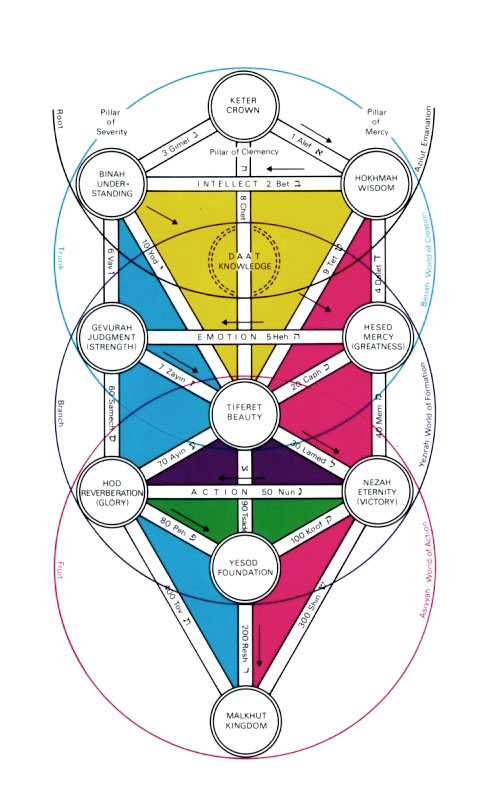
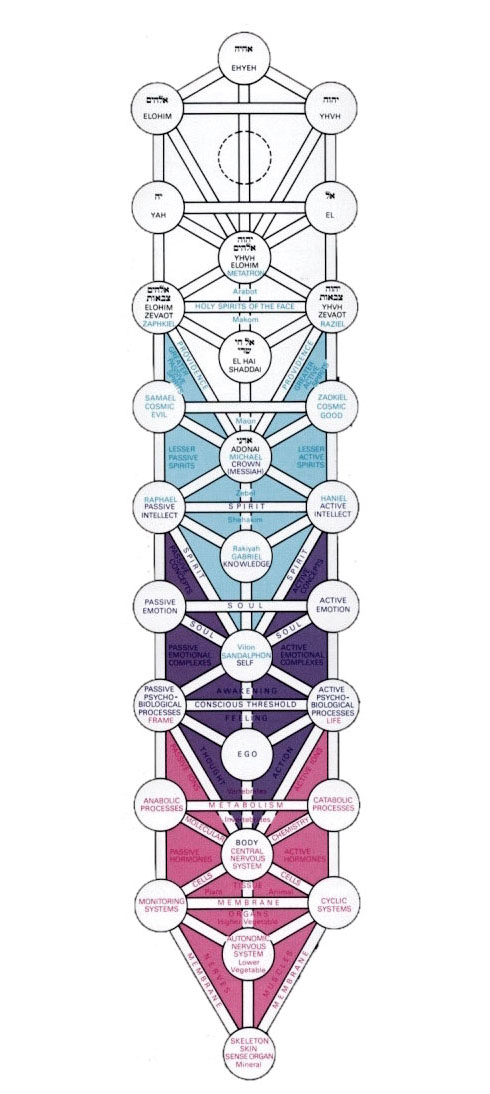
READERS’ COMMENTS
0 Comments